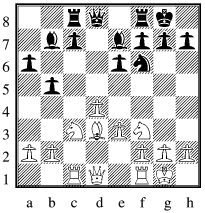
March 2012

|
| Dean Hartley v RR after 12 ... Rc8 |
13 ... c5, 14 dxc5 Rxc5, 15 a4 expected b4, though happy to swing the rook over to h5
15 ... Bxf3 Probably better to push b4 myself first, but decided on an immediate disuption of the pawns around the white king.
16 gxf3 b4, 17 Ne4 Nxe4, 18 fxe4 a5, 19 Rxc5 Bxc5, 20 e5 Clearing a diagonal for his bishop to hit h6, but overlooking
20 ... Qg5+, 21 Kh1 Qxe5, 22 Bb1 Qd5+, 23 f3 Rd8, 24 Rc1 g6 Not necessary, but I feel happier taking time out to prevent back row mates if I'm wanting to make full use of my rook.
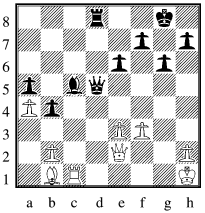
|
| Dean Hartley v RR after 24 ...g6 |
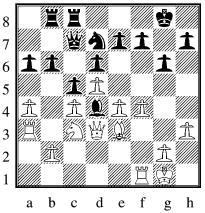
|
| RR v Wiatt Ropp after 18 Rfc8 |
19 Rfa1 Bxc3 presumably to enable b5, but white's bishop should surely now become a dominant piece.
20 Qxc3 b5, 21 axb5 axb5, 22 Ra7 Rb7, 23 Rxb7 Qxb7, 24 b3 Rb8
25 e5 bxc4, 26 bxc4 Qb4, 27 Bd2 Qxc3, 28 Bxc3 Kf8, 29 Rc1 Pathetic. RR gives up his attacking chances for what? a limp defence of his c-pawn.
29 ... Rb3, 30 exd6 exd6, 31 Kf2 Ra3, 32 Ke3 Ra2, 33 Bd2 f5
34 g4 Nf6, 35 g5 Ne4, 36 Be1 Ra3+, 37 Ke2 Rxh3 RR's limp defensive play deservedly leads to loss of pawn
38 Ra1 Retakes the a-file he should never have abandoned.
38 ... Ke7, 39 Ra7+ Kd8, 40 Rg7 Ke8, 41 Ra7 Rh1, 42 Ra8+ Kf7 43 Ra7+ Ke8 1/2-1/2
To stop the checks black has to move the king to the queenside, when white swings the rook to the g-file to discourage h6. With black's knight controlled by he white bishop it is not obvious how black should proceed to make use of his pawn advantage.
RR was given another white to finish the day, against Colin Searle. We join the game with RR content with his position, having just kicked the black queen away from b6. He has the better light squared bishop and is well placed to play b4 and a4 to expand on the queenside. However his brain has omitted to tell him this and he embarks on manoeuvres of unclear purpose.
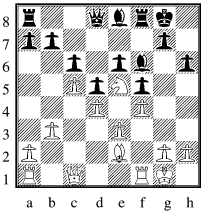
|
| RR v Colin Searle after 17 ... Qd8 |
22 ... gxf4, 23 exf4 Rg8, 24 Ra3 Qg7 Panic! He's forked my d-pawn and mate on g2 (my knight was completely off my radar for some reason at this point).
25 Rg3 Bxd4+, 26 Kh1 Qh8, 27 Rd3 Bf6, 28 Rb3 Bd7, 29 Bd3 Rg6
30 b5 axb5, 31 axb5 Ra1, 32 bxc6 Bxc6, 33 Nf3 Rxf1+, 34 Bxf1 Qa8
35 Qe2 Qa1, 36 Re3 Bd7, 37 Ne5 Bxe5, 38 Rxe5 Rg8 Black's bishop is still inferior to mine, but I surely cannot expect that to last. His last move shows intent to bring his rook around to the a-file. A glimmer of hope.
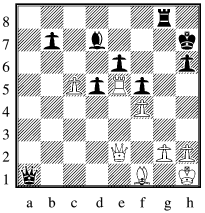
|
| RR v Colin Searle after 38 ... Rg8 |
Then make some threats:
41 Qh5 Kg7, 42 Qh4 Kg6 Stops a check, but allows my bishop to wake-up - a real comic book "with one bound he was free". Qxe5 also does not work as I have a check before playing fxe5 back.
43 Be2 Qd4 (again Qxe5 does not work), 44 Bh5+ Kg7, 45 Qe7+ Kh8
46 Qd8+ Kg7, 47 Qxd7+ Kh8, 48 Qe8+ Kg7, 49 Qg6+ Kh8, 50 Qxh6+ Kg8
51 Qxe6+ 1-0
comment on this article
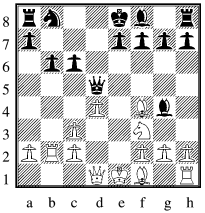
|
| David Ireland v RR after 10 Bf4 |
10 ... Bxf3, 11 Qxf3 Qxf3, 12 gxf3 e6, 13 Rg1 f6, 14 h4 Kf7
15 h5 Be7 Had originally intended playing g5 at this point to slow kingside activity, but when the time came elected to pursue further development. Getting a rook to e8 in pursuit of a bishop exchange was the chosen approach.
16 Bd3 f5, 17 Be5 Bf6, 18 f4 Bxe5, 19 fxe5 Rd8, 20 Ke2 Rd5 21 Rg5 Ra5, 22 Bc4 Na6, 23 Rxf5+ Missing this simple trick says a lot about my alertness, or lack thereof. Again had thought of g6, with Nd7 and Nf8 to hold the resulting kingside position together for a while, but distracted by he thought of getting my knight to d5.
23 ... Ke7, 24 Rg5 Rg8, 25 Rb1 Nc7, 26 Rbg1 Nd5 Fast asleep, RR waves goodbye to another pawn. The rest of the game is a vain attempt to find a get out of jail card lying around somewhere.
27 Rxg7+ Rxg7, 28 Rxg7+ Kf8, 29 Rxh7 Nxc3+, 30 Kd3 Nd5, 31 h6 Ra3+
32 Bb3 a5, 33 Ra7 Kg8, 34 Ke4 a4, 35 Bxd5 cxd5+, 36 Kf4 Rh3
37 Kg5 Rh2, 38 Kg6 Rg2+, 39 Kf6 Rxf2+, 40 Kxe6 Rxc2, 41 Rxa4 Rc6+
42 Kxd5 Rxh6, 43 Ra7 Kf8, 44 e6 b5, 45 Kd6 Rh4, 46 d5 Re4
47 Rb7 b4, 48 Kc5 Re2, 49 Rxb4 Rxa2, 50 Rb7 Ra8, 51 d6 Ke8
52 Kc6 Kd8 53 e7+ Ke8 54 Kc7 1-0
Afternoon and white against Leif Dixon.
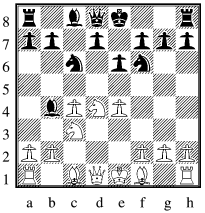
|
| RR v Leif Dixon after 6 Bb4 |
Division 1
|
Division 2
|
Knights and Newcastle still lead the way in Division two, and whilst Macclesfield now surely have too few games left to top the pile, but earlier postponements may well mean that Cheddleton's current position is false.
Division 3
|
Division 4
|
It has been a busy four weeks in division four, with the effect to be to accentuate the difference between the leading three teams and the rest. Nevertheless the title is now looking like Cheddleton E's to lose, whilst Newcastle E look to have the best claim on last place.
The County cups have now reached the semi-final stage. Cheddleton and Stafford both remain in both the Hickman and Gothard competitions. Stafford were also in the Jackson semi-finals, but this is the one such match to have been played and they lost to Lichfield, so North Staffs interest in this competition resides with Fenton in the other semi-final. In the Withnall Fenton and Meir are flying the flag for the north.
comment on this article
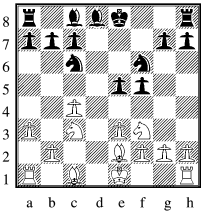
|
| Clive Ferry v RR after 9 a3 |
11 Rd1 Na5 Not only does RR appear to be allergic to shoving the e-pawn, but now he abandons it - white has
12 Nxe5 Rxe5, 13 Rxd8+ to win the pawn, though black is best advised to retain the bishop pair.
12 Nd2 Clive prefers to keep the white knight out of b3.
12 ... Be6, 13 b4 Nc6, 14 Bb2 e4, 15 Nb3 b6, 16 Nd5 Kf7 Another move that scores the famous "nul points". Clive sets about extending his advantage.
17 Rac1 Ne7, 18 Nf4 Ng6, 19 Nxe6 Rxe6, 20 c5 Ne5, 21 Nd4 Re8
22 Bb5 Rf8, 23 Nxf5 Kg6, 24 Ng3 Neg4, 25 Bxf6 Bxf6, 26 Bc6 Nxf2
27 Bxa8 Nxd1, 28 Bxe4+ Kf7, 29 Rxd1 Bh4, 30 Rf1+ Bf6, 31 Bxh7 Re8
32 Ne4 Rh8, 33 cxb6 cxb6, 34 Nxf6 gxf6, 35 Bc2 Rc8, 36 Bb3+ Kg7
37 Kf2 Rc3, 38 Rb1 a5, 39 bxa5 bxa5, 40 a4 Kg6, 41 Bd1 Rc7
42 Rb5 Ra7, 43 h4 Ra6, 44 g4 Kh6, 45 Kf3 Kg6, 46 Kf4 Kg7
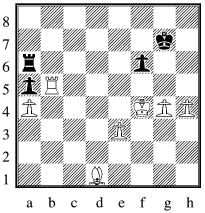
|
| Clive Ferry v RR after 46 ... Kg7 |
47 e4 Kg6, 48 e5 fxe5+, 49 Rxe5 Kg7, 50 g5 Kg8, 51 h5 Kh8
52 Kf5 Ra8, 53 g6 Rd8, 54 h6 Rf8+ At least RR avoids taking the bishop
55 Kg5 Rg8, 56 Bb3 Thankyou. At least I can threaten stalemate. Should extend the game further.
56 ... Rxg6+, 57 Kf4 Rxh6, 58 Rxa5 Kg7, 59 Rf5 How do I get my king passed his rook to help stop the pawn? Lets try
59 ... Rb6, 60 Rb5 Ra6, 61 Ke4 Kf8, 62 Kd5 Ke7, 63 Kc5 Kd8
64 Rb6 Ra7, 65 Kb5 Kc7, 66 a5 Ra8, 67 a6 Rh8, 68 Bd5 Rh5
69 Kc5 Rxd5+ and RR escapes with a draw.
comment on this article
1 d4 Nf6, 2 c4 g6, 3 Nf3 Bg7, 4 Nc3 0-0, 5e4 d6
6 Be2 e5, 7 d5 The Petrosian variation. My first time facing this
move although I did try it with white once, and Kramnik did well with it in the mid 1990s. Closing the centre early is commital but it does restrict my development and the Bg5 pin is annoying as it makes it harder for me to get in f5.
7 ... a5, 8Bg5 h6, 9Bh4 Na6 This move is book and aims to hold up white's queenside play. However, the knight is stuck on the rim. The chief alternative would have been 7...Nbd7. However, after 8 Nd2 the knight cannot get to c5 and rather blocks the development of my play.
10 Nd2 Nice and solid, overprotecting e4 in the event of ...Nc5 and crucially preventing ...Nh5, again making my kingside counterplay much slower.
10 ... Nc5 This looked very logical. My plan being to play Bd7 and Qe8 so that the knight can hop to a4 when white gets b4 in. However, looking at the game now I feel that it is a significant inaccuracy which my opponent failed to exploit.
11 0-0 Bd7, 12 b3
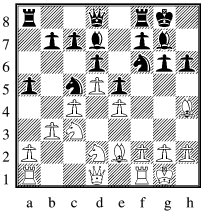
|
| J Vickery v Daniel Sullivan after 12 b3 |
The next thought was developing kingside play with
12 ... Qe8, 13 a3 Nh7, 14 Rc1 f5, 15 f3 and white is all set for b4. Then, ...Na4 is met by Nb5 when I'm in a real tangle. So I'm forced to retreat with ...Na6 and basically gifted white two moves for his queenside attack. Plus, my Nh7/Qe8/Bg7 do seem a little congested and I think any kingside play will be very slow. I was trying to exploit the weakness of b3 and see if I could play on the queenside with some combination of ...c6 and...b5 and exploit the offside white dark squared bishop. It was at this point that I spotted an interesting move and after spending fifteen minutes looking at it decided to go for it.
12 ... Nfxe4 Everyone pretty much assumed that I had lost my marbles at this point, including my opponent who had had the position up to white's thirteenth move before. [Up to and including white's twelfth? : RR]
13 Bxd8 Nxc3
The first point to note is that 14 Bxc7 isn't any good after
.. .Nxd1 15 Raxd1 Ra6 16 Bxa5 Rxa5 17 b4 Rxa2 18 bxc5 dxc5. So white is obliged to accept all the material on offer ... which he did extremely quickly, giving him a twenty five minute lead on the clock.
14.Qe1 Rfxd8
Although the capture with the a rook may look more logical so that the rooks can be placed on the e and f files to support the advance of my central pawns it is very important to have my a5 pawn defended, tying
down his Ra1 to the a2 pawn. If we stop and assess the position now I have bishop, knight and pawn for the queen. So in effect seven points versus nine. However, I've always been told that an unopposed King's Indian bishop is worth at least a rook. Also I'm been told a knight on the sixth is worth a rook too, and ... Nxe2 followed by ... e4 and ... Nd3 isn't hard to envisage. So, am I really that much material down? +/= 0.32 says Fritz at this point. I
also have a clear plan of ...Re8, ...f5, ...e4, ...f4 and ...Bf5 followed by ...e3. This all seemed to flow naturally, but what got me more and more interested in this position was that it was so blocked and I couldn't see how white
could open it to allow his rooks and queen to get active. Any attempt at a3 and b4 to open the a file and I just play ...e4 and ...Nxe2 and I'm the one who will take the a file! Even if white does get an open file on the kingside I
assumed that I would just be able to get an outpost for a minor piece on that file and block it off. Plus, what is white's plan? Giving back material seems an admission of failure and something that I don't think is going to help
unless he can open the position. In fact his only piece with prospects is the knight which can possibly get to b5....so all I need to do is try and stop that.
15 f3
This queen sacrifice [the one initiated by 12 ... Nfxe4: RR] has been played three times previously after it's debut by Kasparov versus Kramnik in a blitz game in 1994 (thanks to Paul B for finding this game, as it isn't in a book I have on Kasparov's greatest games).
15 Rc1 was played by Kramnik, which just loses the a2 pawn and allows my c3 knight a really nice outpost on b4 and white's problems remain....he can't do anything other than await the black build up.
15 Nb1 has also been played in the only game white won in this variation. The key question is do I play
15...Nxe2, 16 Qxe2 e4, 17 Nd2 Bxa1, 18 Rxa1 f5? In this position my lack of dark squared control is a real hinderance as white can open the a file, plus the white knight has good prospects on d4 or b5. I would like to think that I wouldn't have taken the offered exchange if this position had arisen, as the more pieces that come off the easier it is for white to do something as his cramp lessens. However, if I do not take the exchange white can play Nb1 - c3 - b5, which does ease his position and I may well have to exchange my light squared bishop for it, which might allow white to open the kingside. I think 15 Nb1 is definitely the critical response to the queen sacrifice. 15 f3 has been played once before. I was quite pleased to see this move as it weakens the dark squares further and doesn't interfere with my plan ... yet doesn't really help white in any way that I could see.
15 ... f5 Fritz already prefers black!
16 a3 Played in order to activate the a1 rook and get it out of the firing line of the King's Indian bishop. However, it weakens b3, in some lines my g7 bishop can hop in to b2 and just take the pawn on a3 and is it really part of any plan for white?
16 ... e4 Stopping 17 b4 which is now met by
... axb4 18 axb4 Rxa1 followed by ...Nxe2+. Probably best at this point is
17 fxe4 Ncxe4, 18 Nxe4 Bxa1, 19 Qxa1 Nxe4 when I have nine points for the queen and no real weaknesses. However, the position is starting to open up and maybe some combination of Qd4, Bd3 and Re1 could tie me down. Of course taking the exchange is not forced, but with less pieces on the board I feel white's queen will start to make her presence felt.
17.Rc1 Bd4+ Fritz actually recommends 17... e3 here.
With the idea 18 Nb1 Nxe2+, 19 Qxe2 Nxb3 and the knight is going to get to d4 to support the pawn. The bishop on d4 turns out to be vulnerable, although at the time I felt the check looked very natural.
18 Kh1 Nxe2, 19 Qxe2 e3, 20 Nb1 Nxb3 Eight points for the queen, although I have given up on my d3 outpost. My passed pawn is a monster. The white queen is reduced to blockading it and I still can't see how white can open the position for his major pieces. My only problem is my light squared bishop which might take a bit of time to get into the game.
21 Rcd1
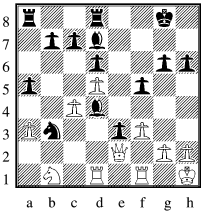
|
| J Vickery v Daniel Sullivan after 21 Rcd1 |
22 Rd3 Instead of this 22 Rxd4 Nxd4, 23 Qd3 c5, 24 dxc6 Nxc6, 25 Re1 Ne5 and if 26 Qxe3 Nd3 wins. However, white has plenty of alternatives on move 26 and it looks like my e3 pawn drops, when I prefer white. 21 ... Bc5 was better. Same plan just a different move order.
22 ... a4, 23 f4 White can't allow me to play ... f4 myself, but this just gives me the e4 square which I can use for doubling rooks and attacking c4 and f4. Plus, ... b5 is now on the cards finally bringing the light squared bishop into the game.
23...Bc5 Eyeing a3, vacating d4 for the knight and keeping options open egarding ...b5.
24 Nc3 This loses material, but it is hard to know what to suggest as white is in a real bind now and my knight and King's Indian bishop are better than any of white's pieces.
24 ... Nd2, 25 Rxd2 Otherwise c4 and a3 drop and I will have three passed pawns and the activity of my pieces increased further.
25 ... exd2, 26 Qxd2 Bxa3, 27 Nb5 White's first active move since the opening. It is the only way to allow white to open up the kingside, and without counterplay I just double rooks, attack f4/c4 and push the a pawn. However, I do think it makes my job much easier as there are less obstacles to my a pawn now.
27 ... Bxb5, 28 cxb5 Bc5, 29 g4 a3, 30 gxf5 gxf5, 31 Qc3 Finally some counterplay with threats of Qh3 and Rf3-g3. Although of course every move towards my king reduces the pieces blocking the a pawn.
31 ... Rf8, 32 Rf3 If 32 Qh3 Kg7 33 Re1 Rae8 and after an exchange of rooks the pawn will promote whilst 34 Ra1 will eventually lose too.
32...Rf7 Defending against the attack.
33 Rf1 a2, 34 Ra1 Rg7 35 h4 35 Qf6 was suggested by PB here. I was planning on playing
35 ... Re8 and if 36 Qxf5 Bd4 with threats of promotion and mate on e1. If 35 Qb2 Kf7 36 Qxa2 Reg8 (threatening mate) 37 h4
Rg3 (threatening to win the queen) 38 Kh2 Bg1+) entering a queen versus rooks endgame with an extra pawn and four isolated pawns to attack.
35 ... Rg1+, 36 Kh2 Rxa1 0-1
If 37 Qxa1 Bd4, 38 Qxd4 a1=Q and the new queen covering f6 prevents any perpetuals.
comment on this article
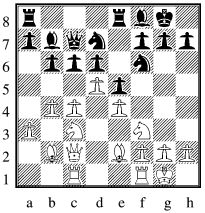
|
| RR v Derrick Wallace after 13 d5 |
13 ... c5, 14 Nb5 Qb8, 15 Nd2 a6, 16 Nc3 cxb4 Derrick decides its time for action
17 axb4 a5, 18 Ba3 axb4, 19 Bxb4 Ba6, 20 Rb1 With more action due on the queenside there is something to say for returning the rook to the a-file and using the f-rook on the b-file.
20 ... Qc8, 21 Qb3 Nc5, 22 Bxc5 bxc5
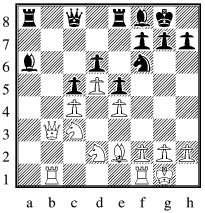
|
| RR v Derrick Wallace after 22 ... bxc5 |
26 Rfd1 Nxe4 27 Nxe4 Rxe2
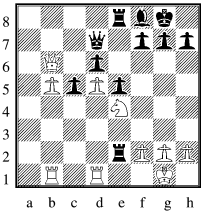
|
| RR v Derrick Wallace after 27 ... Rxe2 |
28 ... e4, 29 Nc4 Ra2, 30 Ne3 f5, 31 Qc6 Qf7, 32 b6 f4
33 Nc4 Raa8 Showing too much respect for white instead of shoving the e and f pawns to victory. Indeed I can have the pawn back now with Nxd6, but reasons buried in the muddy mire of my mind, I declined.
34 Ra1 Rac8, 35 Qb5 e3, 36 Ra7 e2, 37 Re1 Qxd5, 38 b7 Qd1
39 Qa5 Rb8, 40 Qc3 d5, 41 Nb2 Qd4, 42 Qxd4 cxd4, 43 Nd3 g5
44 h3 Unfortunately can't play f3 as this would allow Re3, forcing my knight to move with disastrous consequences.
44 ... Kf7, 45 Ra8 Rxb7, 46 Rxe8 Kxe8, 47 Rxe2+ Re7, 48 Kf1 Re4
49 Ke1 Bd6, 50 Kd1 Kd7, 51 Ra2 Re7, 52 Ra7+ Kc6, 53 Rxe7 Bxe7
54 Kc2 Bd6, 55 Kb3 Kb5, 56 f3 Bc7, 57 Nb2 Bd6, 58 Nd3 It is not apparent how black can make further progress, so draw agreed.

|
| RR v Derrick Wallace final position |
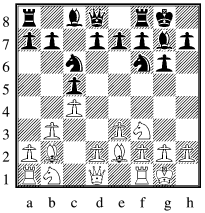
|
| RR v Phil Birks after 7 0-0 |
7 ... e6 8 Qc2 RR returns the compliment. Normally he would want to play a3 first to prevent the c6 knight harrassing the queen, but with a certain gung-ho attitude RR decided that
8 ... Nb4, 9 Qc3 Nh5, 10 d4 with a3 to follow wouldn't be too unsound a line.
8 ... b6, 9 a3 Bb7, 10 d4 d6, 11 Nbd2 Rc8, 12 Rfd1 Qc7
Seems a good idea for RR to keep a black pawn on the c-file, and he chooses to achieve this with a further advance.
13 d5 Phil can win a pawn with
13 ... exd5, 14 cxd5 Nxd5, but I believe
15 Bxg7 Kxg7, 16 Nc4 gives adequate compensation
13 ... Ne7, 14 dxe6 e4 with significant space advantage must be stronger, but at least with the d-file to play with plans shouldn't be too difficult to come by.
14 ... fxe6, 15 Ng5 Qd7, 16 Bf3 d5, 17 cxd5 exd5, 18 Nc4
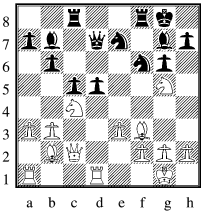
|
| RR v Phil Birks after 18 Nc4 |
18 ... Qf5, 19 Qxf5 Nxf5, 20 Ne6 Rf7, 21 Ne5 Nd7, 22 Nxg7 Rxg7
23 Bxd5+ Bxd5, 24 Rxd5 Nxe5, 25 Bxe5 The smoke clears with RR a pawn up and about to double his rooks.
25 ... Re7, 26 Rad1 Kf7, 27 g4 Ng7, 28 f4 Ne8 29, Kf2 c4
30 Rc1 Ke6, 31 Rd4 b5, 32 bxc4
Two pawns down, and with my bishop dominating his knight Phil calls it a day. 1-0.
comment on this article